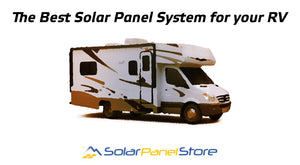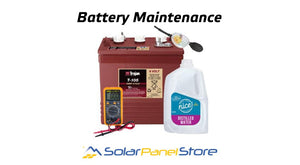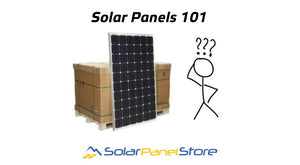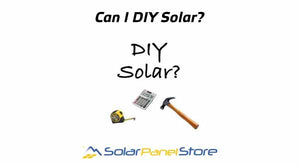Battery Maintenance
To get the most life and performance out of your solar system's batteries, regular battery maintenance is key. In this article we cover some basic principles of flooded deep cycle battery maintenance. Please keep in mind all battery systems are different and you should consult your battery data sheet for information specific to your batteries.
Battery Basics.
Voltage. What is your battery bank voltage? Typical battery voltages include 12V, 24V and 48V, 36V is also found in some instances. Remember that series wiring (positive to negative) will increase voltage while keeping amperage the same. Parallel wiring (positive to positive and negative to negative) will increase amperage, while keeping your voltage the same.
Battery Type. What type of battery are you using? Common battery types include deep-cycle flooded, AGM and gel batteries. Lithium batteries are not yet as common for off-grid applications due to the cost, but they are becoming more popular. AGM, Gel, and Lithium batteries are sealed, maintenance-free, and more expensive than flooded deep cycle batteries. Because this article is about battery maintenance, we won’t focus on these other battery types.
Capacity. Battery capacity for solar systems is measured in amp hours based on a C/20 discharge rate. The faster a battery is discharged, the less capacity it has. C/20 is a slower discharge rate that approximates the typical discharge time period of a solar system. While amp hour capacity can vary by the battery case size, it is common to see 12 volt batteries around 100 amp hours and golf cart style 6 volt batteries around 225 amp hours and L16 size 6 volts around 400 amp hours. Also if you convert capacity into watt hours you can better estimate how much capacity you need to power the loads you have. Because Ohm’s law tells us that watts = volts x amps, a 12 volt 100 amp hour battery is 1200 watt hours. Because the maximum discharge level for deep cycle batteries (“dept of discharge”) is generally 50%, that means that a 1200 watt hour battery only has 600 watt hours of usable capacity.
Tools. Below is a list of tools you’ll need to do your battery maintenance:
- Eye protection
- Gloves
- Wrench
- Voltmeter
- Baking Soda
- Battery Post Cleaner
- Distilled Water
- Hydrometer
- Vaseline
- Notepad
Visual Inspection.
The first step is a visual inspection. But before you do, ALWAYS be sure to wear eye-protection and gloves when working on a flooded deep cycle battery bank! And wear old clothes!
A visual inspection includes checking all the batteries. Be sure to look for cracks or irregular bulges. Check for any fluid on or around the batteries. Cracked or leaking batteries will need to be replaced. Also be sure to inspect cable lugs and battery terminals. These should be clean of fluids, dirt and corrosion. Inspect cable connections for tightness. All connections should be at the proper torque value, which can be found in your battery’s data sheet. Be sure to not over-tighten connections as this can lead to battery damage and hot spots. While connections that are too loose result in poor conduction and hot spots.
Make regular visual inspections of your battery bank a habit. Early problem detection can save a lot of time, money and headaches down the road. Shoot for monthly inspections until you get a good idea of how your batteries perform. Over time you may find that monthly inspections are too frequent, or not enough! How frequent really depends on how hard they are working.
Battery Tests.
After you finish visually inspecting your batteries, there are two important tests you should do as part of regular maintenance: 1) Open Circuit Voltage Testing and 2) Specific Gravity Testing. Performing these tests each month will provide you with important information about your batteries’ health, age and charge level. They will also help you detect problems like overcharging, undercharging and overwatering. Finding these issues early is key to keeping the entire battery bank strong.
Specific Gravity.
Testing the specific gravity of a battery’s electrolyte solution with a hydrometer is an accurate way to measure a battery’s “State of Charge”. As a lead acid battery discharges, sulfuric acid floating in the electrolyte binds back to the charging plates (forming lead sulfate), which makes the electrolyte more water-like and less dense and causes the Specific Gravity to go down. The reverse is true when the battery charges (Specific Gravity goes up as lead sulfate from the plates changes to sulfuric acid in the electrolyte solution). Also if your battery’s electrolyte level gets too low, the density goes up and Specific Gravity goes up.
- Don’t add water at this time, If your batteries are low on water you should add water and let them go through a complete cycle before testing.
- Fill and drain your hydrometer at least 3-4 times before taking your test sample.
- Take a sample, you should have enough liquid to completely support the float.
- Take a reading and record it. Return the sample to the cell.
- Move to the next battery cell and repeat the above 3 steps.
- Be sure to check all the battery cells.
- Replace all battery caps and clean any liquid that may have spilled in the process.
- Correct the readings to 80 degrees fahrenheit by:
- Adding 0.004 for readings 10 degrees fahrenheit below 80 degrees
- Subtract 0.004 for readings 10 degrees fahrenheit above 80 degrees
- Compare the readings.
- Check the state of charge using the below table.
Readings should be at factory specifications of 1.227 +/- 0.007. If any specific gravity is reading low follow the below steps.
- Check and record voltage levels.
- Put batteries on a complete charge.
- Take specific gravity tests again.
If after reading specific gravity you find cells registering low you may try the below steps.
- With your voltage meter check voltages again.
- Proform an equalization charge.
- Take specific gravity tests again.
After your equalization charge has finished and your still getting lower voltage readings than factory specifications you may have one or more of the below conditions:
- The battery was left too long in a state of discharge.
- The battery was over-watered during the last maintainence procedure.
- A weak or bad cell is developing inside the battery.
- Electrolyte was spilled or has leaked from the battery.
- The battery is reaching the end of its life.
If you are showing signs like those above you may want to take your battery in to a specialist, or consider replacing the battery.
Open Circuit Voltage.
When testing open circuit voltage, batteries should remain idle with no charging or discharging for 6 hours. It is best to let them sit idle for 24hrs.
- Disconnect all loads from batteries.
- Measure voltage using a DC Voltmeter (or a Multimeter set to DC voltage)
- Check battery state of charge with the below table.
- Charge the battery if it registers 0% to 70%
If your batteries are registering below the table 1 values, the batteries may have been left too long in a state of discharge, or the battery may have a bad cell. In this case it is best to take the battery to a specialist or replace the battery.
Battery Watering.
All flooded batteries use distilled water as a key component of their electrolyte solution. While not everyone loves checking and adding water to batteries, because flooded batteries are a lot less expensive than sealed batteries, it is worth doing, and doing right. There are some battery watering products on the market today such as the Trojan Hydrolink, and the BWT system by US Battery that are not within the scope of this article, but make the battery watering process easier and quicker.
Distilled water should be added after the battery has been fully charged. However, the water level should at least cover the battery plates before charging. That will ensure that the water levels are sufficient during the different states of charge. Also, keeping your battery plates covered will keep them from being exposed to air, which can cause corrosion to the plates.
It is also important not to overfill the batteries with water. Overfilling can result in the battery overflowing and losing battery acid which will degrade the capacity of the battery. Battery acid is a highly corrosive liquid and can cause damage to anything it touches. Battery containment trays can help avoid damage as they provide a safe place to catch any overflowing acid-containing electrolyte. You should use a distilled or deionized water for watering because these liquids have very low mineral counts. Because the battery electrolyte is a mixture of water and battery acid, always wear protective gloves and eye protection when handling or maintaining batteries to protect your skin and eyes from damage. It’s also best to wear old clothes!
Steps to adding water to a battery:
- Put on your protective eye protection and gloves.
- Remove vent caps and check the inside fill wells.
- If the battery plates are exposed add just enough water to cover these plates.
- Put your batteries on a complete charge before adding any additional water.
- After your batteries are have finished charging open vent caps and check the fill wells.
- Add water until the water level is about ⅛ below the bottom of the fill well.
- Clean and replace the vent caps.
You should never add battery acid to a battery.
Below is an example of the Trojan Battery fill wells and where your water level will need to be.
Battery Cleaning.
Regularly cleaning your battery terminals ensures that current will flow through your battery bank smoothly which, in turn, helps make sure all your batteries receive an equal and full charge.
Steps to battery cleaning.
- Put on your eye protection and gloves.
- Make sure all vent caps are tight.
- Clean the battery tp with a cloth or brush with a solution of baking soda and water.
- Clean battery terminals and lugs with a post cleaner.
- You may want to use a protective coating of anti-corrosive spray or silicon gel.
- Clean the area around the batteries this should be a dry organized area.
Keeping a small notebook as your maintenance journal can be helpful to record your maintenance dates and test results so you can compare readings and determine the best maintenance schedule.
Batteries and Solar.
The goal with any battery-based solar system is to maximize the health and life of your battery bank. Why? Because the battery bank is often the most expensive component of your system. So be sure to charge your batteries completely after use. Batteries that are not fully recharged soon suffer from reduced charging capacity and a shorter life span. If you are going to store the batteries for an extended period of time you will want to charge them fully every three to six months. Flooded batteries can be expected to self-discharge up to 15% each month. This self-discharge rate can depend on the age of the batteries and also the temperature they are stored at.
It is also important that you size your solar array to be large enough that it will fully recharge your battery bank in 4-5 hours during an average sunny day. That will help your battery bank stay fully charged as often as possible to ensure long battery life.
We hope you found this article helpful. Following these recommendations should help you keep your deep cycle, flooded batteries healthy and extend their life and your investment for years to come.














